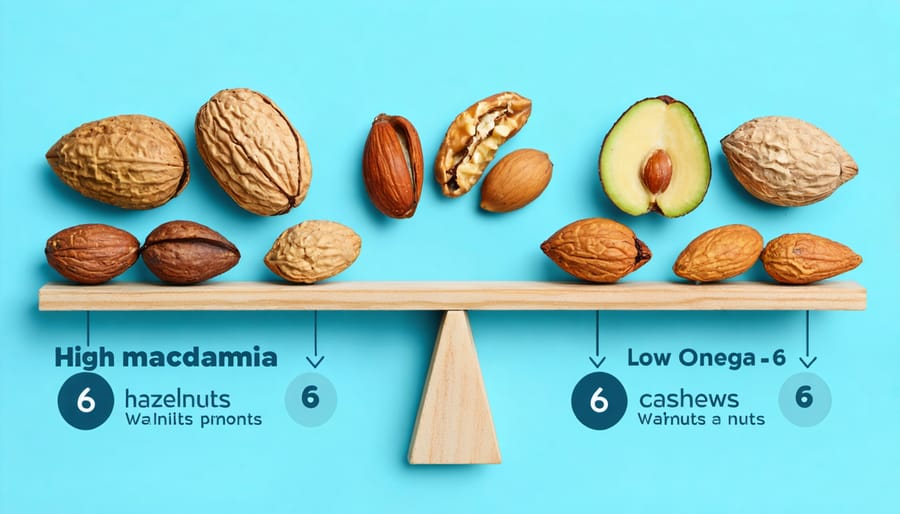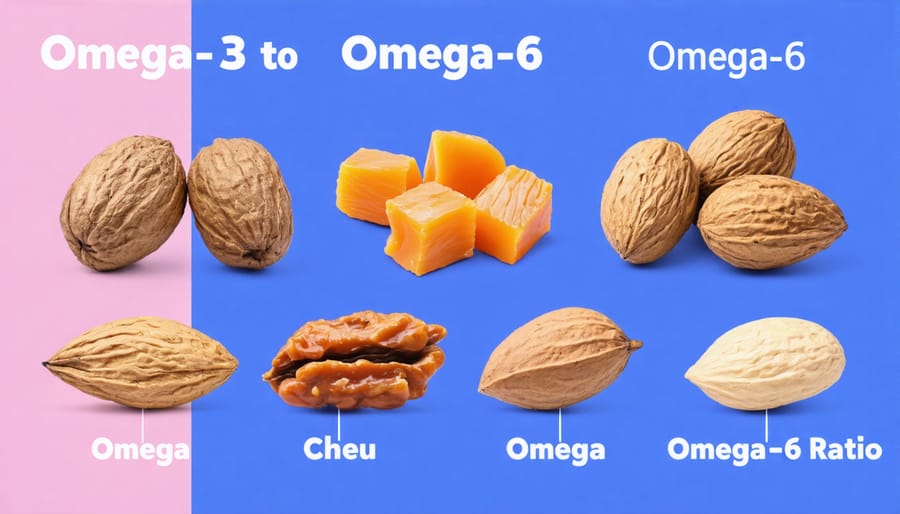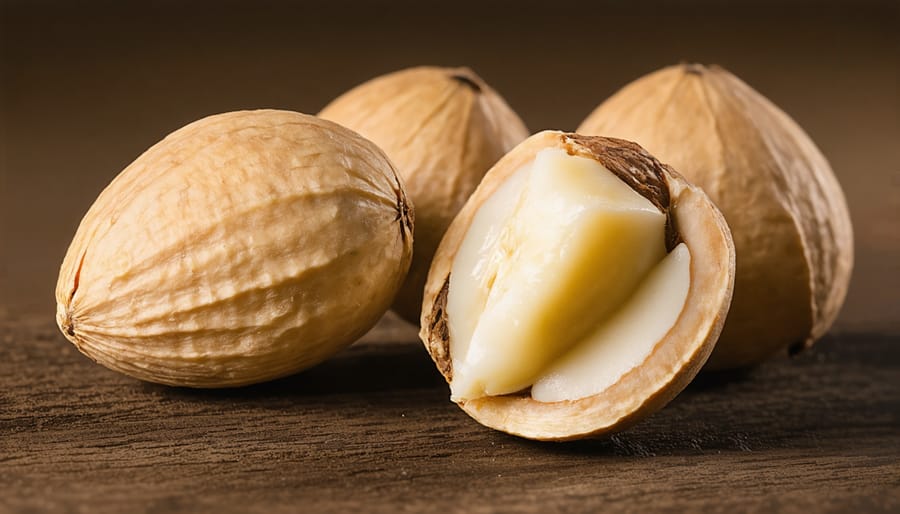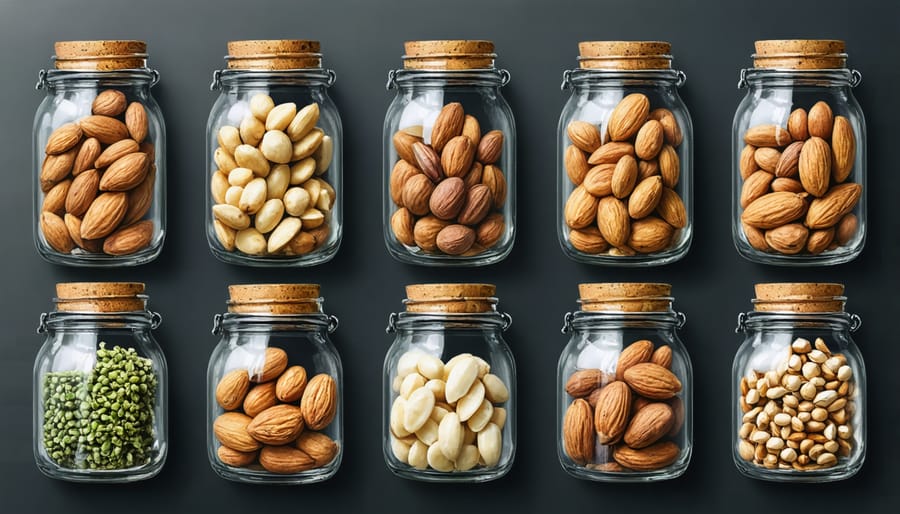
Swap out high-omega-6 nuts like almonds and walnuts for macadamia nuts, hazelnuts, and cashews to dramatically improve your omega fatty acid ratio. Choose these strategic alternatives as part of a balanced nutritional approach to reduce inflammation and support overall wellness. Macadamia nuts stand out as the lowest omega-6 option, containing just 1.3 grams per 100-gram serving – nearly ten times less than almonds.
Store these inflammation-fighting nuts in airtight containers away from direct sunlight to preserve their delicate fatty acid profile. Replace conventional nut butters with macadamia or hazelnut spreads for a simple way to reduce omega-6 intake while still enjoying creamy, satisfying flavors in your daily meals. When snacking, portion out one ounce (about 10-12 nuts) to maintain the perfect balance of healthy fats without overdoing it.
Why Your Nut Choice Matters for Omega Balance
The Omega Balancing Act
Think of your body’s omega balance like a delicate seesaw – when one side gets too heavy, things start to tip out of whack. While both omega-3 and omega-6 fatty acids are essential for our health, most of us are getting way too much of the latter. The ideal ratio should be somewhere between 1:1 and 1:4 (omega-3 to omega-6), but in typical Western diets, it’s more like 1:15 or even 1:20!
This imbalance can lead to inflammation and other health concerns, which is why being mindful of our omega intake is so important. I learned this the hard way when dealing with persistent inflammation issues, and adjusting my nut choices made a noticeable difference. The good news? By choosing nuts with lower omega-6 content, we can help restore that balance without giving up the satisfying crunch and nutritional benefits we love from our favorite snacks.
Not All Nuts Are Created Equal
When I first started learning about omega fatty acids, I was surprised to discover that not all nuts pack the same nutritional punch. While nuts are generally healthy, some varieties contain significantly higher levels of omega-6 fatty acids than others. Think of it like choosing players for your wellness team – some nuts are simply better suited for the role of maintaining a healthy omega balance.
Macadamia nuts and hazelnuts emerge as the all-stars, containing the lowest amounts of omega-6 fatty acids among all nuts. They’re followed by cashews and almonds, which offer moderate levels. On the flip side, walnuts, pine nuts, and pecans tend to be higher in omega-6s, though they still offer valuable nutrients. Understanding these differences helps us make smarter choices when grabbing a handful of nuts for a snack or adding them to our favorite recipes.
Remember, it’s not about completely avoiding certain nuts – it’s about creating balance in your overall diet.

Best Low Omega-6 Nuts for Your Health

Macadamia Nuts: The Omega-6 Champion
When I first discovered macadamia nuts, I thought they were just another delicious tropical treat. Little did I know these creamy, buttery nuts would become my go-to snack for maintaining a better omega fatty acid balance. Among all nuts, macadamias stand out as the true champions of low omega-6 content, making them a perfect choice for anyone looking to reduce their omega-6 intake.
What makes macadamias so special? These Australian natives contain just 1-2% omega-6 fatty acids, while most other nuts clock in at 20% or higher. Instead of omega-6, they’re rich in heart-healthy monounsaturated fats, similar to those found in olive oil. This unique fatty acid profile makes them an excellent choice for those of us working to achieve a better omega-3 to omega-6 ratio in our diets.
I love keeping a small container of macadamias in my desk drawer for afternoon snacking, but they’re incredibly versatile in the kitchen too. Try crushing them to make a gorgeous crust for fish, blending them into smoothies for extra creaminess, or chopping them as a topping for your morning oatmeal. While they might be a bit pricier than other nuts, their nutritional benefits and rich, satisfying taste make them worth the splurge.
Remember to store your macadamias in an airtight container in the fridge to preserve their delicate oils and prevent them from going rancid. A small handful (about 10-12 nuts) makes for a perfect serving size.
Beautiful Benefits of Brazil Nuts
If you’re looking for a nutritional powerhouse that won’t tip your omega balance, Brazil nuts deserve a special spot in your pantry. While many nuts are high in omega-6 fatty acids, Brazil nuts contain moderate levels, making them a smart choice for those watching their fatty acid ratios.
But here’s where these chunky nuts really shine – they’re the richest known food source of selenium, a mineral that supports thyroid function and helps boost your immune system. Just one Brazil nut can provide your entire daily selenium needs! I remember discovering this fact during a nutrition workshop, and it completely changed how I view these impressive nuts.
Beyond their moderate omega-6 content, Brazil nuts offer a beautiful array of other benefits. They’re packed with magnesium, which helps with muscle function and mood regulation, and copper, which supports collagen production for healthy skin. The healthy fats and protein content make them incredibly satisfying, perfect for those afternoon energy slumps we all know too well.
I love adding two or three Brazil nuts to my morning smoothie or chopping them up for a nutrient boost in my homemade granola. Just remember – with Brazil nuts, more isn’t always better. Because of their high selenium content, stick to 1-3 nuts per day to reap the benefits without overdoing it.
Pro tip: Store your Brazil nuts in the refrigerator to keep them fresh longer and preserve their delicate nutrients.
Hazelnuts: Your Heart’s Friend
I’ll never forget the first time I discovered hazelnuts beyond their famous role in chocolate spreads. These little powerhouses are actually one of the smartest choices when it comes to balancing your omega fatty acids, and they’ve become my go-to afternoon snack.
What makes hazelnuts particularly special is their well-balanced fatty acid profile. While many nuts are high in omega-6 fats, hazelnuts contain a more moderate amount, making them an excellent choice for those watching their omega-6 intake. They’re rich in heart-healthy monounsaturated fats, similar to what you’d find in olive oil, and contain a modest amount of omega-3s too.
Just a small handful (about one ounce) of hazelnuts provides you with vitamin E, manganese, and fiber, while keeping your omega-6 levels in check. I love adding them to my morning yogurt or tossing them into salads for a satisfying crunch. They’re especially delicious when lightly toasted, which brings out their natural sweetness and nutty aroma.
For the best results, store your hazelnuts in an airtight container in the refrigerator – this helps preserve their delicate oils and prevents them from going rancid. Try incorporating them into your baking or simply enjoy them as a wholesome snack when those afternoon cravings hit.
Smart Ways to Include Low Omega-6 Nuts in Your Diet
Beyond Snacking: Creative Kitchen Ideas
Let’s transform those low omega-6 nuts into delicious kitchen creations! I love incorporating these nutritious gems into my daily cooking routine through mindful food preparation. Here are some of my favorite ways to use them:
Try blending macadamia nuts with a touch of water and sea salt to create a luxuriously creamy sauce for pasta or roasted vegetables. For a quick breakfast upgrade, sprinkle chopped hazelnuts over your morning oatmeal or yogurt bowl – they add the perfect crunch!
Create a signature nut-crusted fish or chicken by grinding macadamias or hazelnuts with herbs and using them as a coating. The natural oils in these nuts create a beautiful golden crust when baked.
For baking enthusiasts, try substituting processed flour with finely ground macadamia nuts in your favorite cookie recipes. They add richness while keeping those omega-6 levels in check. I also love making a mixed nut butter using primarily low omega-6 options – it’s incredibly satisfying and versatile.
Remember to store your nuts in an airtight container in the fridge to maintain their freshness and prevent their natural oils from oxidizing. This simple step ensures your nuts stay delicious for all your culinary adventures!

Storage Tips for Maximum Freshness
Just like many of you, I learned the hard way that nuts can go from deliciously fresh to disappointingly stale when not stored correctly. Following proper storage techniques is essential to maintain both the taste and nutritional benefits of your low omega-6 nuts.
Store your nuts in airtight containers – I love using glass jars with tight-fitting lids. Keep them in a cool, dark place away from direct sunlight and heat sources. Your pantry is perfect, but avoid storing them near the stove or dishwasher where temperature fluctuations occur.
For longer shelf life, pop them in the refrigerator where they’ll stay fresh for up to six months. If you’re buying in bulk (hello, savings!), the freezer is your best friend – nuts can last up to a year when frozen. Just remember to bring them to room temperature before enjoying to experience their full flavor.
Quick tip: Write the purchase date on your storage containers – this simple habit has saved me from the “are these still good?” dilemma more times than I can count. And trust your senses – if your nuts smell rancid or taste bitter, it’s time to replace them.
As we’ve explored together, incorporating low omega-6 nuts into your daily routine doesn’t have to be complicated or overwhelming. By choosing options like macadamias, hazelnuts, and cashews, you’re taking a mindful step toward better nutrition while still enjoying delicious, satisfying snacks. Remember, it’s not about completely eliminating omega-6 fatty acids – they’re essential nutrients, after all – but rather about finding that sweet spot of balance in your diet.
I’ve found that keeping a mix of these nuts in my pantry makes it easier to grab healthier options throughout the day. Whether you’re sprinkling them on your morning yogurt, adding them to your favorite salad, or enjoying them as an afternoon pick-me-up, these nuts can easily become part of your daily routine.
Start small, experiment with different combinations, and listen to your body. The journey to better nutrition is personal, and there’s no one-size-fits-all approach. By making informed choices about the nuts you consume, you’re already on your way to a more balanced and nourishing lifestyle.



